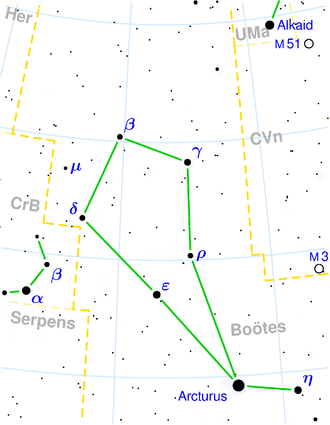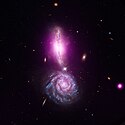UGC 9618
| Galaxie UGC 9618 | |
|---|---|
 | |
| Aufnahme des Hubble-Weltraumteleskops | |
| AladinLite | |
| Sternbild | Bärenhüter |
| Position Äquinoktium: J2000.0, Epoche: J2000.0 | |
| Rektaszension | 14h 57m 00,4s[1] |
| Deklination | +24° 36′ 44″ [1] |
| Erscheinungsbild | |
| Morphologischer Typ | DBL SYS LINER [1] |
| Helligkeit (B-Band) | 14,3 mag |
| Winkelausdehnung | 1,6′ × 0,6′ [1] |
| Physikalische Daten | |
| Rotverschiebung | 0,032863 ± 0,000315 [1] |
| Radialgeschwindigkeit | (9852 ± 94) km/s [1] |
| Hubbledistanz vrad / H0 | (444 ± 31) · 106 Lj (136,0 ± 9,6) Mpc [1] |
| Geschichte | |
| Katalogbezeichnungen | |
| UGC 9618 • PGC 53432/53433 • CGCG 134-058 • MCG +4-35-18/19 • IRAS 14547+2448 • Arp 302 • VV 340 • KPG 446 | |
UGC 9618 (auch VV 340 oder Arp 302) ist ein wechselwirkendes Galaxienpaar im Sternbild Bärenhüter, das etwa 450 Millionen Lichtjahre von der Milchstraße entfernt ist. Es handelt sich um zwei sehr gasreiche Spiralgalaxien in einem frühen Stadium der Verschmelzung. Die Galaxie in Kantenstellung trägt die Bezeichnung VV 340 Nord, diejenige in Draufsicht VV 340 Süd. Halton Arp gliederte seinen Katalog ungewöhnlicher Galaxien nach rein morphologischen Kriterien in Gruppen. Dieses Galaxienpaar gehört zu der Klasse Unklassifizierte Doppelgalaxien.
Im Jahr 2011 wurde dieses Paar mit dem Chandra-Röntgenteleskop beobachtet: Durch die gravitative Wechselwirkung der beiden Sternsysteme werden die in ihnen befindlichen Ansammlungen aus Gas und Staub zur Bildung einer großen Zahl massereicher blauer Sterne angeregt. Daher strahlen die beiden Galaxien auch im blauen sichtbaren Licht so intensiv. Diese Sterne sind so heiß, dass sie große Mengen an Röntgenstrahlung aussenden. Da die beiden Galaxien aber auch im langwelligen infraroten Licht sehr leuchtkräftig sind, werden sie auch als „leuchtstarke Infrarot-Galaxien“ (luminous infrared galaxies, LIRG) bezeichnet.[2]
Weblinks
- Hubble-Weltraumteleskop
- ARP ATLAS OF PECULIAR GALAXIES
- Seligman Arp
- astronews.com: Bild des Tages 2. März 2012
Literatur
- Jeff Kanipe und Dennis Webb: The Arp Atlas of Peculiar Galaxies – A Chronicle and Observer´s Guide, Richmond 2006, ISBN 978-0-943396-76-7
Einzelnachweise
Auf dieser Seite verwendete Medien
UGC 9618, also known as VV 340 or Arp 302 consists of a pair of very gas-rich spiral galaxies in their early stages of interaction: VV 340A is seen edge-on to the left, and VV 340B face-on to the right. An enormous amount of infrared light is radiated by the gas from massive stars that are forming at a rate similar to the most vigorous giant star-forming regions in our own Milky Way. UGC 9618 is 450 million light-years away from Earth, and is the 302nd galaxy in Arp's Atlas of Peculiar Galaxies.
This image is part of a large collection of 59 images of merging galaxies taken by the Hubble Space Telescope and released on the occasion of its 18th anniversary on 24th April 2008.
| About the object | |
|---|---|
| Object name | UGC 9618, VV 340, Arp 302, VV 340A, VV 340B, KPG 446B |
| Object description | Interacting Galaxies |
| Position (J2000) | 14 57 00.90 +24 37 01.7 |
| Constellation | Bo tes |
| Distance | 450 million light-years (150 million parsecs) |
| About the data | |
| Data description | The Hubble image was created using HST data from proposal 10592: A. Evans (University of Virginia, Charlottesville/NRAO/Stony Brook University) |
| Instrument | ACS/WFC |
| Exposure date(s) | January 6, 2002 |
| Exposure time | 33 minutes |
| Filters | F435W (B) and F814W (I) |
Description: This composite image of VV 340 contains X-ray data from Chandra (purple) and optical data from Hubble (red, green, blue). The two galaxies shown here are in the early stage of an interaction that will eventually lead to them merging in millions of years. The Chandra data shows that the northern galaxy contains a rapidly growing supermassive black hole that is heavily obscured by dust and gas. Data from other wavelengths shows that the two interacting galaxies are evolving at different rates.
Creator/Photographer: Chandra X-ray Observatory
NASA's Chandra X-ray Observatory, which was launched and deployed by Space Shuttle Columbia on July 23, 1999, is the most sophisticated X-ray observatory built to date. The mirrors on Chandra are the largest, most precisely shaped and aligned, and smoothest mirrors ever constructed. Chandra is helping scientists better understand the hot, turbulent regions of space and answer fundamental questions about origin, evolution, and destiny of the Universe. The images Chandra makes are twenty-five times sharper than the best previous X-ray telescope. NASA's Marshall Space Flight Center in Huntsville, Ala., manages the Chandra program for NASA's Science Mission Directorate in Washington. The Smithsonian Astrophysical Observatory controls Chandra science and flight operations from the Chandra X-ray Center in Cambridge, Massachusetts.
Medium: Chandra telescope x-ray
Date: 2011
Persistent URL: <a href="http://chandra.harvard.edu/photo/2011/vv340/" rel="nofollow">chandra.harvard.edu/photo/2011/vv340/</a>
Repository: <a href="http://chandra.harvard.edu/photo/" rel="nofollow">Smithsonian Astrophysical Observatory</a>
Gift line: X-ray: NASA/CXC/IfA/D.Sanders et al; Optical NASA/STScI/NRAO/A.Evans et al




